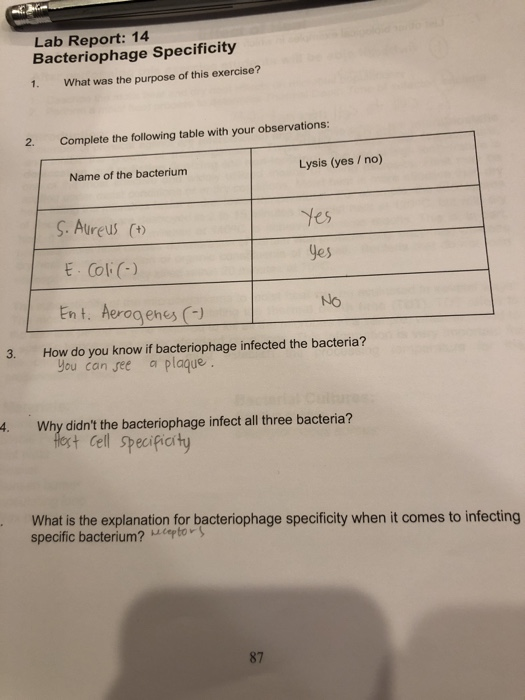QQuestionAnatomy and Physiology
QuestionAnatomy and Physiology
# Lab Report: 14 Bacteriophage Specificity
1. What was the purpose of this exercise?
2. Complete the following table with your observations:
| Name of the bacterium | Lysis (yes / no) |
| --- | --- |
| S. Aureus (1) | Yes |
| E. Coli ( - ) | Yes |
| Ent. Aerogenes ( - ) | No |
1. How do you know if bacteriophage infected the bacteria?
You can see a plaque. 4. Why didn't the bacteriophage infect all three bacteria?
Hest Cell Specificity
What is the explanation for bacteriophage specificity when it comes to infecting specific bacterium? "ceptors
Attachments

6 months agoReport content
Answer
Full Solution Locked
Sign in to view the complete step-by-step solution and unlock all study resources.
Step 1**Step 1:** The purpose of this exercise is to study the specificity of bacteriophages in infecting different types of bacteria.
**Step 2:** Complete the following table with your observations: | Name of the bacterium | Lysis (yes / no) | | --- | --- | | S. Aureus (1) | Yes | | E. Coli (−) | Yes | | Ent. Aerogenes (−) | No | **Step 3:** You can determine if a bacteriophage infected the bacteria by observing the formation of plaques. Plaques are clear areas on a bacterial lawn that indicate the lysis (destruction) of bacterial cells due to bacteriophage infection. **Step 4:** The bacteriophage did not infect all three bacteria because of bacteriophage specificity. Bacteriophages are viruses that specifically infect and replicate within certain bacteria. This specificity is determined by the interaction between bacteriophage receptors (found on the viral capsid) and specific receptors on the surface of the bacterial cell. If the bacteriophage receptors do not match the bacterial receptors, the bacteriophage will not be able to infect the bacterium. In this case, the bacteriophage was able to infect S. Aureus and E. Coli, but not Ent. Aerogenes. This suggests that the bacteriophage used in this experiment has receptors that can recognize and bind to receptors on S. Aureus and E. Coli, but not on Ent. Aerogenes. **
Final Answer
If the receptors are compatible, the bacteriophage can infect the bacterium, leading to the formation of plaques. In this exercise, the bacteriophage was able to infect S. Aureus and E. Coli, but not Ent. Aerogenes.
Need Help with Homework?
Stuck on a difficult problem? We've got you covered:
- Post your question or upload an image
- Get instant step-by-step solutions
- Learn from our AI and community of students